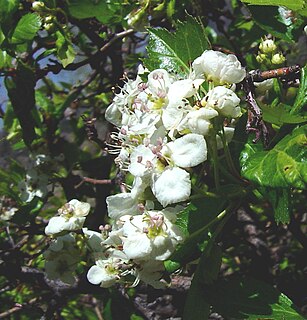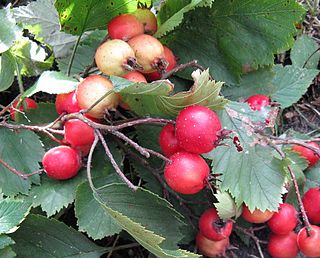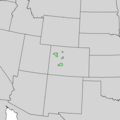
Crataegus, commonly called hawthorn, quickthorn, thornapple, May-tree, whitethorn, Mayflower, or hawberry, is a genus of several hundred species of shrubs and trees in the family Rosaceae, native to temperate regions of the Northern Hemisphere in Europe, Asia, North Africa, and North America. The name "hawthorn" was originally applied to the species native to northern Europe, especially the common hawthorn C. monogyna, and the unmodified name is often so used in Britain and Ireland. The name is now also applied to the entire genus and to the related Asian genus Rhaphiolepis.

Crataegus mollis, known as downy hawthorn or red hawthorn, is a species of plant that occurs in eastern North America from southeastern North Dakota east to Nova Scotia and southwest to eastern Texas. The range of this species is from southern Ontario and Michigan to eastern North Dakota and southward to Denison, Texas, and Arizona. This tree inhabits wooded bottomlands, the prairie border, and the midwest savanna understorey.

Crataegus laevigata, known as the Midland hawthorn, English hawthorn, woodland hawthorn, or mayflower, is a species of hawthorn native to western and central Europe, from Great Britain and Spain east to the Czech Republic and Hungary. It is also present in North Africa. The species name is sometimes spelt C. levigata, but the original orthography is C. lævigata.

Crataegus douglasii is a North American species of hawthorn known by the common names black hawthorn and Douglas' thornapple. It is most abundant in the Pacific Northwest.
Crataegus brachyacantha is one of the "black-fruited" species of hawthorn, but it is only very distantly related to the other black-fruited species such as C. douglasii or C. nigra. The common names blueberry haw and blueberry hawthorn refer to the appearance of the fruit, which are almost blue, and does not refer to their taste. The species is rarely cultivated but has ornamental leaves, flowers, and foliage. It is native to Louisiana, and also occurs just across the border of neighbouring states.

Crataegus chrysocarpa is a species of hawthorn that is native to much of the continental United States and Canada. Common names fireberry hawthorn and goldenberry hawthorn, as well as the scientific name all refer to the colour of the unripe fruit, although the mature fruit is red and in var. vernonensis is "deep claret-colored … nearly black when over-ripe".

Crataegus crus-galli is a species of hawthorn known by the common names cockspur hawthorn and cockspur thorn. It is native to eastern North America from Ontario to Texas to Florida, and it is widely used in horticulture. It is thought to be the parent, along with Crataegus succulenta, of the tetraploid species Crataegus persimilis.

Crataegus erythropoda is a hawthorn native to the southern Rocky Mountains in the United States. The leaves are conspicuously shiny above and fruit ("haws") are dark purplish red. It is seldom cultivated, but at one time was listed in the nursery trade under the common name "Chocolate Haw". It is closely related to C. rivularis which has fruit that are fully black when ripe.

Crataegus marshallii is a species of hawthorn known by the common name parsley hawthorn. It is native to the southeastern United States.

Crataegus pentagyna, also called small-flowered black hawthorn, is a species of hawthorn native to southeastern Europe. Two subspecies are recognized, C. p. subsp. pentagyna and C. p. subsp. pseudomelanocarpa. The fruit are usually black, but are sometimes a handsome purple.

Crataegus punctata is a species of hawthorn known by the common names dotted hawthorn or white haw that is native to most of the eastern United States and eastern Canada. While some sources claim it is the state flower of Missouri, the actual legislation does not identify an exact species. Furthermore, the Missouri Department of Conservation asserts the Crataegus mollis was specifically designated as the state flower.

Crataegus rivularis is a species of hawthorn known by the common name river hawthorn. It is native to the intermontane region of the northwestern United States, situated between the coastal ranges and the Rocky Mountains.

Crataegus submollis, known as the northern downy hawthorn, northern red haw, Quebec hawthorn, or hairy cockspurthorn, is a species of hawthorn that grows to about 7 m in height and typically carries large crops of red fruit.

Crataegus mexicana is a species of hawthorn known by the common names tejocote, manzanita, tejocotera and Mexican hawthorn. It is native to the mountains of Mexico and parts of Guatemala, and has been introduced in the Andes. The fruit of this species is one of the most useful among hawthorns.
Crataegus iracunda, with common name passionate hawthorn, and sometimes called the stolon-bearing hawthorn is a North American species of hawthorn. It was described in 1899 by Chauncey Delos Beadle of the Biltmore Herbarium in North Carolina. Taxonomic opinions have differed about this species, and to complicate matters Crataegus macrosperma and various species of C. series Populneae have frequently been misidentified as C. iracunda, leading to differing statements about its geographic range. The 2015 Flora of North America considers its range to be in the southeastern U.S., restricted to the US states of Alabama, Georgia, Louisiana, Mississippi, North Carolina, South Carolina, and Virginia.
Crataegus okanaganensis is a species of hawthorn native to western British Columbia, Washington state and Montana. It forms a vigorous shrub to 8 m in height with brilliant red fruit in late summer, that later ripen to "burgundy to deep purple ". It has potential as an ornamental plant.

Crataegus phippsii is a species of hawthorn native to south-central British Columbia, Washington state, and Montana. It forms a shrub or small tree to 7 m in height with leaves that have white hair on the underside, and fruit that ripen through red to purplish black. It appears to have potential as an ornamental plant.

Series Molles is a series within the genus Crataegus that contains at least six species of hawthorn trees and shrubs, native to Eastern North America. Some of the species are cultivated as ornamental plants. They have relatively large leaves, large flowers, and bloom early for hawthorns. The plant parts are usually hairy, particularly in early growth, and the fruit are generally red and are large for hawthorn fruit.

Section Sanguineae is a section within the genus Crataegus native to central and eastern Europe and parts of Asia. It includes about 20 species and three series.



















